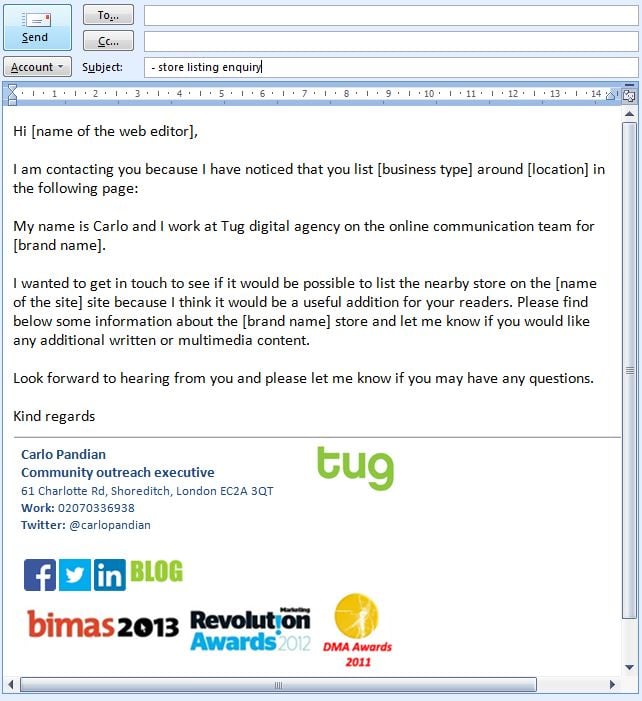Guide to build local citations for stores and physical shops
Once your optimised pages for every store location are built and you have your Google Locals profiles, your next ranking factor are citations. After this you may want to look at reviews.
This guide aims to make citation building quick and simple so you can build those valuable links that drive traffic and also uplift your rankings.
Step 1: Organise citation building tasks
This is how I suggest you organise your citation prospects:
In a Notepad file write down all the business details needed for the store listings. The following are the common data required:
- Name of the shop (if there are multiple shops you want to identify them with a location keywords, example: H&M Oxford Circus)
- Full address
- Phone
- Location page URL
- Description with targeted keywords (for example if you want to rank for the keyword “fashion shop in Westminster” guessing this may be valuable for the H&M Oxford Circus store, include this keyword in the copy)
- Targeted keywords
- Social profiles
Citations opportunities are normally located in directories, blogs with a list of resources and online publishers that contains a business directory. Don’t think about the old school directory full of spammy links, think about the likes of TripAdvisor for travel related business, Zagat for restaurants, FindaStore.co.uk for retailers and Netmums for every children like business.
In some cases, building a citation is as simple as filling out a form, other times you have to e-mail or phone to website administrators. I suggest you create a citation request e-mail template like the following one:
Step 2: Find out citation opportunities
Automated SEO is a word of the past. Citation opportunities can be found with tools like WhiteSparks and GetListed but a manual research via Google would do a similar, if not a better job.
First of all, think where you want to appear. What does your business sell and who’s your target audience? How do users look for H&M if they don’t use the keyword “H&M store near X”?
Here’s what the newbie SEO should think when looking for citations for the newly opened H&M store:
Clothing store, fashion shop, basic clothing store, jacket shop, women fashion shop, man fashion shop, kids fashion shop, jeans store, trendy fashion store, mono brand fashion store
This exercise sounds a bit like the SEO copywriter joke below. However, it helps to find citation opportunities!
So this SEO copywriter walks into a bar, grill, pub, public house, Irish bar, bartender, drinks, beer, wine, liquor…
— Prosek Partners (@ProsekPR) October 26, 2012
Use the same technique for location; let’s say you are looking for citations for the H&M in Oxford Circus store. Here are some examples of location queries variations: Oxford Circus, Regent Street, Oxford Street, West End, Westminster, West London, and London. Other ways to find citations:
- Stalk your competitors citations looking at their business name and address
- Search for the Locations + intitle:directory or inurl:directory
- Search for the Keyword + intitle:directory or inurl:directory
Other ways to build citations is to look at the GetListed resources and get your basic listings on the common directories such as Yelp or Manta.
Step 3: Outreach the business details to your list
At this point you should own a long list of directories and web sites where your citations would be relevant. Carry on submitting details and keep an eye on the verification processes that many directories require before to place your citations.
For blogs and online publishers reaching out to administrators is usually the most effective way with the help of a well crafted e-mail or phone calls.




